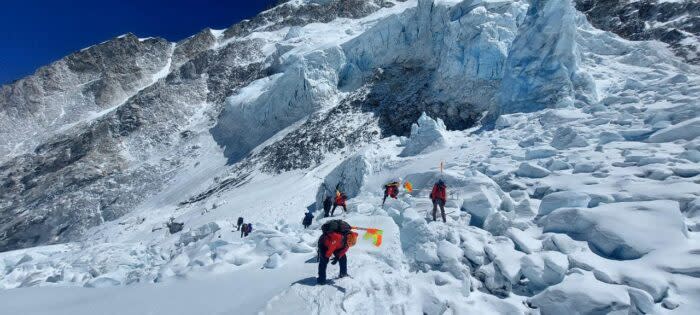Tests carried out on Everest last spring with cargo drones were so successful that Nepal authorities have ruled that these drones will carry gear and retrieve rubbish between Camp 1 and Base Camp in future.
It seems like a great idea. Drones are cleaner and more cost-effective than helicopters. Most of all, they are a safer option for the many porters who risk their lives shuttling several times a season through the treacherous Khumbu Icefall. Nearly 50 people have died amid these seracs since the peak’s first ascent in 1953.
Safety first
“The use of drones on Everest is a natural evolution of technology applied to Himalayan mountaineering,” Dawa Steven Sherpa of Asian Trekking told ExplorersWeb. “[It’s] something helicopters were doing but at a pretty high risk and high cost.”


“Drones will save lives,” agrees Mingma G of Imagine Nepal told ExplorersWeb.
Mingma G knows well the toll the Icefall can take. This past spring, he lost three men when a section of ice collapsed.
“Also,” he told ExplorerWeb, “drones will relieve the crowding at the Khumbu Icefall, and…multiply the amount of rubbish that can be brought down.”
Even the commercial clients should welcome the change since, as Dawa Steven Sherpa points out, “There has always been some guilt and apprehension [among clients] that the sherpas are putting themselves at risk by carrying loads.”
Other peaks too
The measure will proceed not only on Everest but also on other peaks of the Khumbu. The Sagarmatha Pollution Control Committee, the Khumbu Pasang Lhamu Rural Municipality, and Airlift Technology Pvt. Ltd. signed a Memorandum of Understanding “for the use of advanced drone technology to efficiently manage garbage in the mountains of the Khumbu region.”
The Chinese producers at Da Jiang Innovations (DJI) will be in charge of commercializing the drones. It was one of their models tested last spring that prompted the rule change.
“The DJI FlyCart 30, the long-distance heavy lifter drone, could airlift 234kg per hour between Camp I and Base Camp, a task usually accomplished by at least 14 porters in six hours,” The Kathmandu Post reported.
Check out a video about cargo drones on Everest here.
Loss of local jobs?
Some are concerned that jobs could be lost, as expeditions will need fewer porters to carry loads on their back. But the stakeholders see it as an opportunity for sherpas to aspire to better jobs.
“Having the sherpas less engaged in ferrying loads would free them up to assist their clients on the actual climb,” Dawa Steven said. “This is more financially rewarding for them in terms of bonuses and tips. Each commercial client will continue to need/want a sherpa to assist on the climb to the summit, so I would say their jobs are secure.”
Dawa Steven eyes an ambitious future for the Sherpa community. “We foresee that there will be fewer Sherpas working in mountaineering, and those who do will be better trained (UIAGM or similar). The trend is already moving toward sherpas more as guides [than] their traditional role as porters. The drone will act as a catalyst for that.”


Moreover, Jagat Bhusal of the Khumbu Municipality told The Kathmandu Post that there is a plan to train sherpas as drone pilots.
While the drones will operate until Camp 1 (6,000m), porters will remain needed to carry loads across the easier section between Camp 1 on the Western Cwm and Camp 2 (6,400m).
Finally, drones still have a ceiling. Beyond that point, nothing matches the sherpas’ ability to reach higher altitudes.
Will Camp 2 become a new Advanced Base Camp?
Drones might change some climbing strategies. Dawa Steven noted that his own sherpa team hopes in future to be based out of Camp 2. They will pick up the loads at Camp 1 and then stock the high camps. This reduces their passage through the Icefall to just one there and back.
Commercial clients already minimize their rotations by acclimatizing on easier peaks, using hypoxic training at home, and turning to supplementary oxygen at Camp 2.
Better waste disposal but more needed
The measure should also reduce the litter accumulating beyond Base Camp. Last spring, some improvements in the disposal of human waste were a good start. Teams also tried to bring down their gear as they retreated. Drones will help here, but there remains a lot to do to clean up the mountain, especially around Camp 4, located at nearly 8,000m on the South Col.
The post Drones Will Help Sherpas Avoid Everest Icefall Next Year appeared first on Explorersweb.







